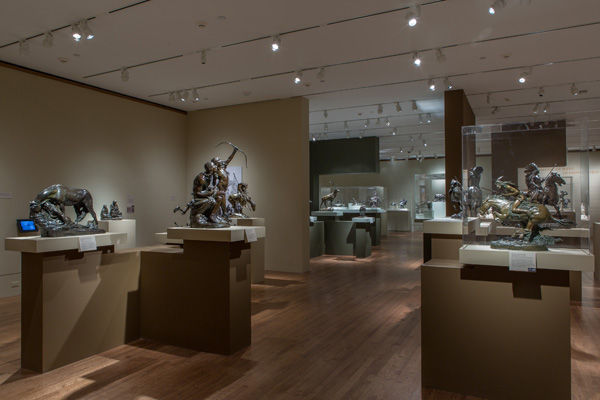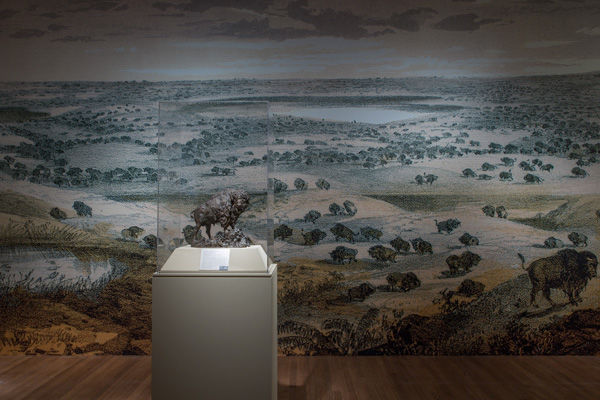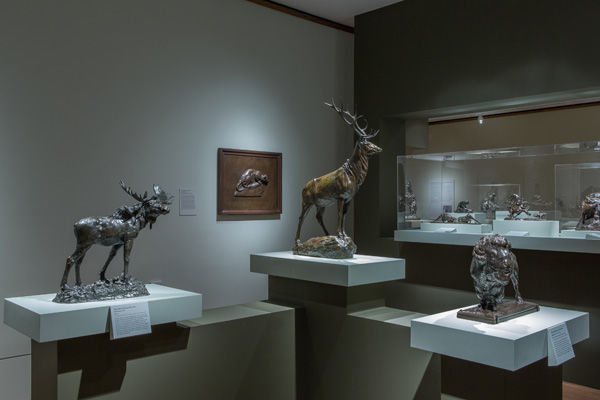
Installation photographs by Wilson Santiago
When designing an exhibition installation, each stage in the planning process requires careful consideration. Decisions are made to best express the show's intellectual objectives and showcase the objects, yet practical concerns and personal preferences also come into play. To better understand how and why such choices are made, I sat down with Michael Lapthorn, Exhibition Design Manager in the Met's Design department, to discuss his work on The American West in Bronze, 1850–1925. Michael collaborated closely with curator Thayer Tolles to translate the exhibition's narrative into three-dimensional reality.
A native of North Dakota, or "Bison Country," as he calls it, Michael has a personal connection to the American West, and his knowledge of the region brought unique insights to the exhibition's design. Although working within the confines of a Z-shaped gallery, Michael aimed to recreate the vast openness of the Great Plains. "I really wanted to have some sense of pastoral horizontality, big long stretches and open vistas with few vertical elements," he said. To immediately convey this distinct natural environment, Michael and Thayer open the show with a large-scale reproduction of John Mix Stanley's Herd of Bison near Lake Jessie (1853–55; State Historical Society of North Dakota), a chromolithograph originally published in a government survey report. Emphasizing the open, rolling expanse of the western terrain, the lithograph serves as the backdrop for the first sculpture visitors will encounter, Henry Merwin Shrady's Buffalo (1899; cast ca. 1901; Amon Carter Museum of American Art, Fort Worth, Texas). This solitary animal is set against the landscape, standing "amongst his buffalo brethren," as Michael noted.

"The lithograph has every element we need: it has buffalo, it has age, it has truth, and it has great color," Michael said. In fact, the soft hues and subtle tonalities of this landscape inspired the exhibition's color palette. Yet selecting wall colors proved to be a challenging task, as Michael explained: "Bronze is very tricky. No matter how much light you put on it, it never gets bright. It is dark and determinedly so. If we went too light with the wall colors everything would look as if it were in silhouette; but if we went too dark, the bronze would look dead." Striking a balance between light and dark, Thayer and Michael selected a natural palette of earth tones with shades of brown, gray, and green.
The exhibition is organized in four sections, which allow the show's themes to unfold, beginning with representations of American Indians, followed by wildlife, cowboys, and settlers. However, space considerations also played an important role in determining the arrangement of the sixty-five sculptures and three paintings. As Michael explained, "I had to use my experience to lay out the objects in my head, imagining how big they are, how detailed they are. I had to determine if people were going to look at them up close or far away, which tells me how much space I need."

Maintaining a sense of spatial openness throughout the exhibition was essential to Michael's design. Not only did he want visitors to have the physical space to walk around the sculptures wherever possible, but he also aimed to create an installation inspired by the western landscape. "I thought about the buttes of Monument Valley and the cinematic quality of the West in order to emphasize a planar horizontality," he said. As a result, he designed long, flat plates resting on thinner substructures to serve as supports for many of the sculptures. He also designed cut-out C shapes in several of the vertical walls, in which shelves are positioned to display sculptures. This technique divides the exhibition space, yet ensures that the gallery maintains its openness. The West's mountainous landscape also inspired Michael's organization of several small wildlife bronzes, many of which are placed on ascending and descending blocks, mirroring the silhouette of mountain peaks.

I hope that this discussion of the exhibition's design will enhance your enjoyment of The American West in Bronze, 1850–1925. I encourage you to share your thoughts and comments, or to ask questions about the installation strategies you encounter when exploring the exhibition.